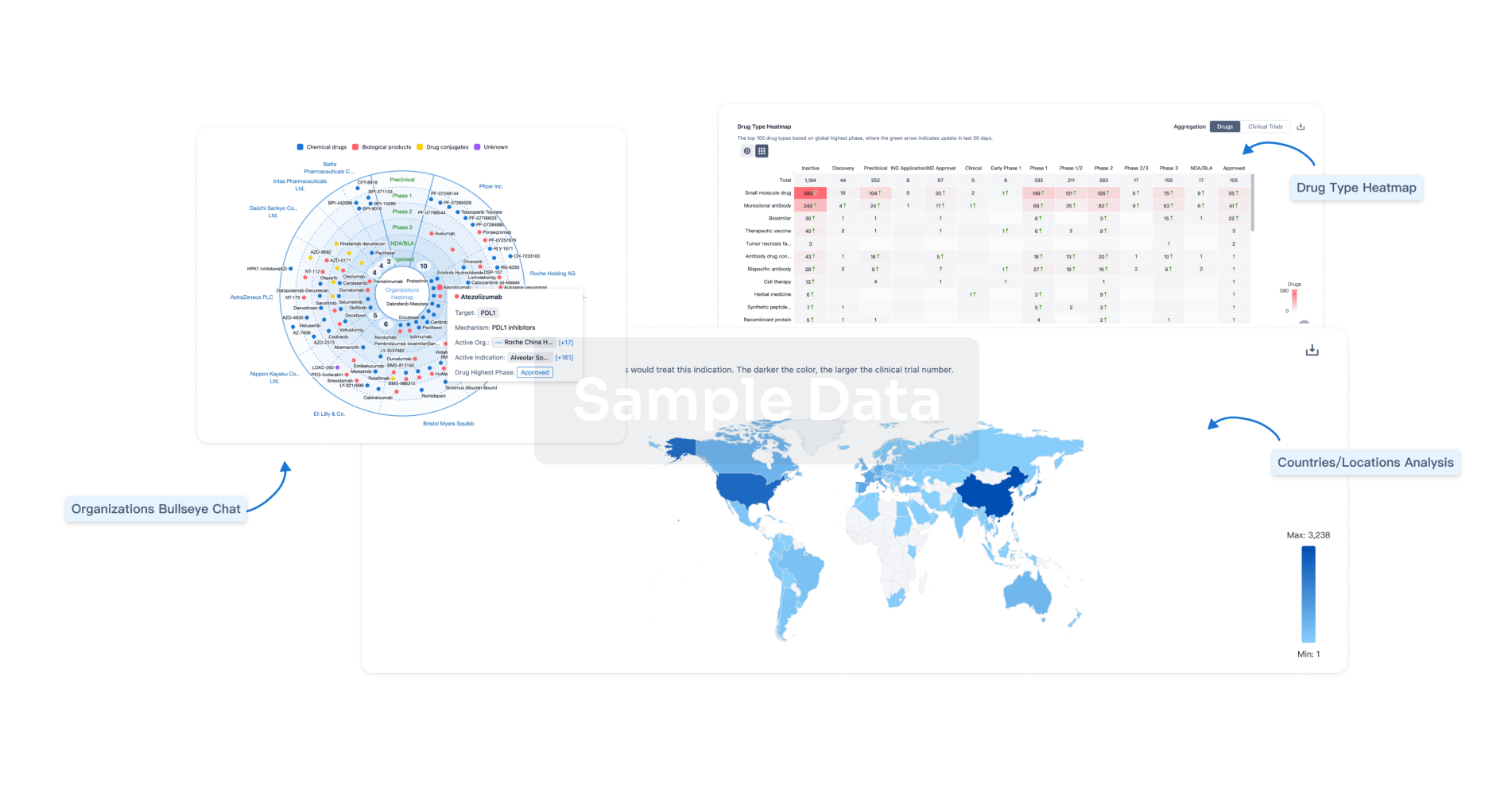Request Demo
Last update 08 May 2025
Long Qt Syndrome 2
Last update 08 May 2025
Basic Info
Synonyms LONG QT SYNDROME 2, LQT2, LQT2 syndrome + [4] |
Introduction An autosomal dominant condition caused by mutation(s) in the KCNH2 gene, encoding potassium voltage-gated channel subfamily H member 2. It is characterized by a prolonged QT interval that may result in torsade de pointes, ventricular fibrillation and/or sudden cardiac death. |
Related
2
Drugs associated with Long Qt Syndrome 2Target |
Mechanism SGK1 inhibitors |
Active Org. |
Originator Org. |
Active Indication |
Inactive Indication- |
Drug Highest PhasePhase 1/2 |
First Approval Ctry. / Loc.- |
First Approval Date20 Jan 1800 |
Target |
Mechanism Nav1.5 blockers |
Active Org.- |
Originator Org. |
Active Indication- |
Inactive Indication |
Drug Highest PhaseDiscontinued |
First Approval Ctry. / Loc.- |
First Approval Date20 Jan 1800 |
4
Clinical Trials associated with Long Qt Syndrome 2NCT05906732
A Phase 1b/2a, 2-Part Study; Part 1: Randomized, Double-Blind, Crossover, Dose-Escalation, Placebo-Controlled Study to Evaluate the Safety, Tolerability, Pharmacokinetics, and Pharmacodynamics of SGK-1 Kinase Inhibition by LQT-1213 on Dofetilide-Induced QTc Prolongation in Healthy Adult Subjects. Part 2: Single-Blind, Multiple-Dose, Safety Study to Evaluate the Safety, Tolerability, and Pharmacokinetics of LQT-1213 in Patients Diagnosed With Type 1, 2 or 3 Long QT Syndrome
Part 1: This is a Phase 1b, randomized, double-blind, crossover, dose escalation, placebo-controlled study to evaluate the effect of oral LQT-1213 on dofetilide-induced QTc prolongation in healthy adult subjects. This is a 2-treatment, 2-period crossover study with approximately up to 28 healthy subjects, with screening procedures within 28 days of enrolment.
Part 2: This is a Phase 2a, single-blind, placebo run-in, multiple-dose safety study to evaluate the safety, tolerability, and PK of LQT-1213 in patients diagnosed with LQT1, LQT2 or LQT3. Up to 12 participants with LQT1, up to 20 participants with LQT2 and up to 12 participants with LQT3 will be recruited.
Part 2: This is a Phase 2a, single-blind, placebo run-in, multiple-dose safety study to evaluate the safety, tolerability, and PK of LQT-1213 in patients diagnosed with LQT1, LQT2 or LQT3. Up to 12 participants with LQT1, up to 20 participants with LQT2 and up to 12 participants with LQT3 will be recruited.
Start Date12 Mar 2023 |
Sponsor / Collaborator |
NCT04581408
Mutation-specific Therapy for the Long QT Syndrome
Novel therapy for the Long QT Syndrome based on the mechanism of action of the disease-causing mutations
Long QT syndrome type 2 (LQT2) accounts for
35% of all LQTS cases and is difficult to manage, as beta-blockers frequently fail to provide full protection. Most LQT2 patients (pts) have a Class 2 mutation, which implies defective "trafficking".
Lumacaftor (LUM) is a drug developed and currently indicated for the treatment of cystic fibrosis (CF) in patients homozygous for the F508del mutation in the CFTR gene. LUM corrects protein folding and trafficking defects of mutant and misfolded CFTR channels, restoring their cell surface expression. The investigators recently demonstrated that LUM can rescue in vitro the LQTS phenotype observed in human induced pluripotent stem cell- derived cardiomyocytes (hiPSC-CMs) from pts with LQT2 Class 2 mutations (PMID: 29020304) and in these same two patients Orkambi administrated for 7 days at the same dosage approved for cystic fibrosis showed to reduce their QTc (PMID: 30753398).
With the present phase II clinical trial (MAST2) the investigators will enroll 20 LQT2 patients (see inclusion and exclusion criteria) and they will test in vivo the efficacy of Orkambi in shortening their QTc. Patients will be admitted to hospital for a maximum of 7 days (minimum in-hospital stay based on evidence of QTc shortening). Orkambi will be administered at the dose approved for cystic fibrosis and during the entire period continuous ECG monitoring through both telemetry and 12-lead 24-hr Holter monitoring will be performed and QTc length and morphology will be analyzed.
Long QT syndrome type 2 (LQT2) accounts for
35% of all LQTS cases and is difficult to manage, as beta-blockers frequently fail to provide full protection. Most LQT2 patients (pts) have a Class 2 mutation, which implies defective "trafficking".
Lumacaftor (LUM) is a drug developed and currently indicated for the treatment of cystic fibrosis (CF) in patients homozygous for the F508del mutation in the CFTR gene. LUM corrects protein folding and trafficking defects of mutant and misfolded CFTR channels, restoring their cell surface expression. The investigators recently demonstrated that LUM can rescue in vitro the LQTS phenotype observed in human induced pluripotent stem cell- derived cardiomyocytes (hiPSC-CMs) from pts with LQT2 Class 2 mutations (PMID: 29020304) and in these same two patients Orkambi administrated for 7 days at the same dosage approved for cystic fibrosis showed to reduce their QTc (PMID: 30753398).
With the present phase II clinical trial (MAST2) the investigators will enroll 20 LQT2 patients (see inclusion and exclusion criteria) and they will test in vivo the efficacy of Orkambi in shortening their QTc. Patients will be admitted to hospital for a maximum of 7 days (minimum in-hospital stay based on evidence of QTc shortening). Orkambi will be administered at the dose approved for cystic fibrosis and during the entire period continuous ECG monitoring through both telemetry and 12-lead 24-hr Holter monitoring will be performed and QTc length and morphology will be analyzed.
Start Date15 Jun 2021 |
Sponsor / Collaborator |
NCT02365506
A Double-blind, Placebo-controlled Study to Evaluate the Effect of GS-6615 on QT, Safety and Tolerability in Subjects With Long QT2 Syndrome
The primary objective of the study is to evaluate the effect of oral eleclazine (formerly GS-6615) on corrected QT (QTc) interval in participants with long QT2 syndrome.
Start Date20 Jul 2015 |
Sponsor / Collaborator |
100 Clinical Results associated with Long Qt Syndrome 2
Login to view more data
100 Translational Medicine associated with Long Qt Syndrome 2
Login to view more data
0 Patents (Medical) associated with Long Qt Syndrome 2
Login to view more data
638
Literatures (Medical) associated with Long Qt Syndrome 201 Jul 2025·Seizure: European Journal of Epilepsy
Loss-of-function variant in KCNH3 is associated with global developmental delay, autistic behavior, insomnia, and nocturnal seizures
Article
Author: Bähring, Robert ; Harms, Frederike L ; Grinstein, Lev ; Kortüm, Fanny ; Bauer, Christiane K ; Alawi, Malik ; Möllring, Anna ; Denecke, Jonas
01 Mar 2025·Pacing and Clinical Electrophysiology
Topological Distribution of KCNH2 Variants and Genotype‐Phenotype Relationship in Patients With Long QT Syndrome
Article
Author: Jiang, Zhenhong ; Hong, Kui ; Brugada, Ramon ; Shen, Yang ; Wang, Daowu ; Liu, Hongyu ; Su, Yuhao ; Shao, Ying
01 Feb 2025·Stem Cell Research
Human induced pluripotent stem cell line XXMUFAi001-A generated from a patient harboring KCNH2 mutation (c. 2690 A>C)
Article
Author: Zhang, Yongchun ; Li, Peicheng ; Liu, Hui ; Pu, Dawei ; Lv, Fenghua ; Zhang, Zhenling ; Fan, Zhenping ; Li, Ya'nan ; Wang, Xiaofeng ; Li, Yuxuan ; Zhang, Junbiao ; Zhang, Shuai ; Niu, Yifang ; Li, Xiaolei
Analysis
Perform a panoramic analysis of this field.
login
or

AI Agents Built for Biopharma Breakthroughs
Accelerate discovery. Empower decisions. Transform outcomes.
Get started for free today!
Accelerate Strategic R&D decision making with Synapse, PatSnap’s AI-powered Connected Innovation Intelligence Platform Built for Life Sciences Professionals.
Start your data trial now!
Synapse data is also accessible to external entities via APIs or data packages. Empower better decisions with the latest in pharmaceutical intelligence.
Bio
Bio Sequences Search & Analysis
Sign up for free
Chemical
Chemical Structures Search & Analysis
Sign up for free


